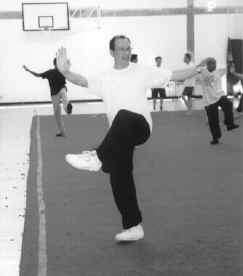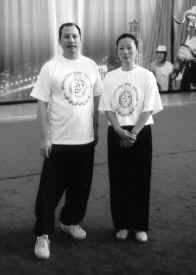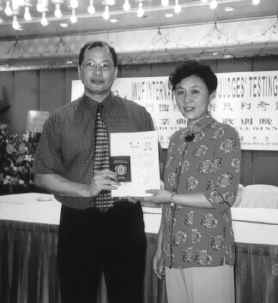|
With the World Wushu Championships coming up again in
September, and with wushu almost certainly being in the 2008 Olympics in
Beijing, competition in wushu is well and truly on the agenda for many
Chinese martial art practitioners. With this in mind, in June this year
six representatives from Australia went to Macao to attempt to become
accredited by the International Wushu Federation as international judges.
Amongst these were Charles Tsui-Po, Vice-President of the TCAA, Richard
Tsui-Po and Di Logan of the Golden Lion Academy, Melbourne. So what did we actually have to do? The program lasted for two weeks. There were two groups in the course – one for Taolu (routines) and one for San Da (free combat). All of the Australian group were doing Taolu. For us, the first week was essentially taken up with practical work on the competition routines during the day and theory sessions at night. You might think that Taiji practitioners would only be expected to know and judge Taiji routines, but, no, we were all expected to at least try to walk through some of the Northern Long Fist, Southern Fist, Southern Broadsword, Southern Staff, Northern Staff, Spear, Fast Straight Sword and Broadsword routines. We were not being trained and tested as judges specialising in one art, but would be accredited to judge any form of wushu routines. Five new compulsory wushu routines have been developed and are being introduced at this year’s World Championships. These are in Northern Long Fist, Spear, Broadsword, Fast Straight Sword, Northern Staff. One of our tasks during the program would be to familiarise ourselves with these new routines. The two Taiji routines, Taijiquan 42 forms and Taijijian 42 forms, have not changed as they are both relatively recent introductions -–especially the Taiji sword routine. We first looked at the routines that were not being changed. In these we went through the routines with expert teachers from Mainland China to ensure that we knew the routine well and to review the technical specifications for each movement. This was not too difficult, although there were a few obvious differences in interpretation of the movements from what we were currently doing at home. Then the fun began – working on the new routines! Imagine learning a routine in a discipline with which you are entirely unfamiliar – 56 movements in two sessions of
two and a half hours each. This was the experience of some of us. Some
were more lucky – they were at least familiar with the weapon and style.
But, even so, it was a huge challenge. Some decided they would learn more
about the art by sitting and watching. Some persisted all the way through.
Both approaches, it turned out, were acceptable. We had time to become at
least slightly acquainted with 2 or 3 of the new routines during the
course.
with which you are entirely unfamiliar – 56 movements in two sessions of
two and a half hours each. This was the experience of some of us. Some
were more lucky – they were at least familiar with the weapon and style.
But, even so, it was a huge challenge. Some decided they would learn more
about the art by sitting and watching. Some persisted all the way through.
Both approaches, it turned out, were acceptable. We had time to become at
least slightly acquainted with 2 or 3 of the new routines during the
course.
The evening theory sessions were equally challenging. They were delivered in Mandarin with interpretation of varying standards. When the lecturer finished speaking and the interpreter started, all the Chinese-speaking people in the audience (and that was about 90%) would begin to chatter, drowning the translation. We gradually came to realise that to pass the theory section we would simply need to know by heart the workbook and rules and regulations book that we had been given. Simple! Oh, and we had to know them word perfectly because our examiners wouldn’t believe we were saying the same thing unless we used exactly the same words. Panic set in! By the end of the first week we were mentally and physically drained. The only reason we were not equally emotionally wrecked was because we didn’t have the energy to be anxious. And still it went on – no break for the weekend! Then we came to the examinations. The first took the form of a practical performance on the floor. We each had to do two routines. We could pick either a new or an old routine, one open hand and one weapon. This was sweaty palm time. Remember we were performing in front of five expert judges and many fellow candidates who were high level competitors themselves. These people really knew their stuff! Next we had an oral test in front of a panel of the five examiners. The questions could be on any of the competition routines from any discipline. We had to answer two questions – one about judging issues like scoring in relation to a routine, and one related much more specifically to the technical specifications of a different routine. One Australian candidate, Di Logan, who had only ever done Taiji before, successfully answered questions on Southern Staff and on Northern Long Fist – much to her own astonishment! The third test was a practical judging test. We judged members of the Macao Wushu Team. We had to note our reasons for any deductions as well as giving a final score and showing clearly which of two performers in each section was the winner. We were evaluated according to how close our scores were to those of our teachers on the course The performers were very good. The non-taiji routines only took around 1 minute 20 seconds. Fortunately we had six practice judgings before our six test judgings. It was so easy to sit mesmerized by the brilliance of the performance, and then to look at a blank sheet in front of you with not a single error noted! As in the World Championships, the taiji competitors were on the floor two at a time. Thank goodness, we had 5 to 6 minutes to look from one to the other to find errors. You find yourself as a judge really searching for errors – particularly in the elite athletes. As we were told in the course, the judge does not give the competitor points. Every competitor starts with 10 points. The judge only deducts points for errors and faults. The final test was a written examination. This was generally not too difficult as long as you had, as I mentioned earlier, memorised word perfectly the work book and rule book. Our major problems with the written paper arose from some interesting English translations of the original Chinese exam paper. Questions became a little obscure. Remember, the examiners wanted an exact word-for-word regurgitation of the books. None of this "put it in your own words to show you understand the meaning." So … the first question: "Wushu, explain" What the …? What do they want? Definition? History? Oh, darn, give them the lot and they can pick. But there’s only 1 centimetre space to write in! Finally all the tests were over. Of course, then the post mortems started. Realisations of mistakes: "Is THAT what they meant?", "Oh no, I left out a complete page of questions!". By the afternoon of the written exam day the English-speaking contingent of the Australian group was in deep depression. We were convinced we had all failed. Rumours flew – all the English-speakers had done very badly, some said. We went out on that evening, a dreary bunch! NOT a cheery night out! The following morning at breakfast, probably seeing our miserable faces, Eric Chen from the USA (the translator of the exam papers) came to put us out of our misery – "Congratulations, you have all passed. In fact, you’ve done very well!" Then he laughed at our dumbfounded faces. Altogether it was an amazing experience. One we have learned from in so many ways. We were told that not many judges last out more than a few competitions. Why? "Because everybody hates you when you are a judge!" In future, whether we are judging, competing, coaching a team, or just barracking, we’ll remember the hard work the judges have put in and the efforts they are making to be fair. Our skills in teaching will benefit from the attention to detail and acute observation we have practiced. Our own practice will benefit in the same way.We’ll remember the many friends we made from so many wide-spread places – Turkey, Canada, Mauritius, Singapore, Switzerland, USA, Vietnam, amongst lots more. This program is a great avenue for networking!
|

 It is important for the competitive side of wushu in
Australia , including taijiquan, that many more people from here take the
opportunity to do this training and accreditation. We need lots more
qualified judges so that we can
hold competitions throughout Australia in
preparation for international competition – especially the Olympics! The
accreditation programs are held every two years prior to the World Wushu
Championships. Information is available from the Australian Kung Fu (Wushu)
Federation. I do recommend that anyone who is interested in seeing this
aspect of wushu develop further in Australia consider becoming accredited
themselves.
It is important for the competitive side of wushu in
Australia , including taijiquan, that many more people from here take the
opportunity to do this training and accreditation. We need lots more
qualified judges so that we can
hold competitions throughout Australia in
preparation for international competition – especially the Olympics! The
accreditation programs are held every two years prior to the World Wushu
Championships. Information is available from the Australian Kung Fu (Wushu)
Federation. I do recommend that anyone who is interested in seeing this
aspect of wushu develop further in Australia consider becoming accredited
themselves.